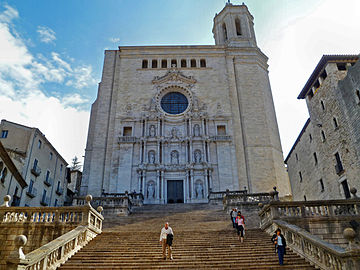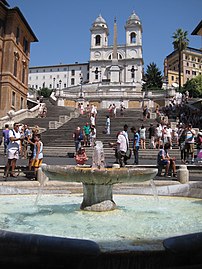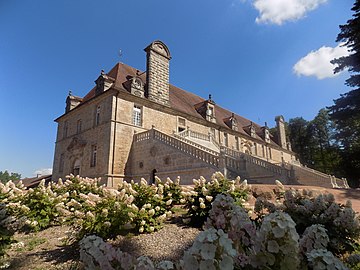
In classical Greek architecture, a stylobate is the top step of the crepidoma, the stepped platform upon which colonnades of temple columns are placed. The platform was built on a leveling course that flattened out the ground immediately beneath the temple.

Stairs are a structure designed to bridge a large vertical distance between lower and higher levels by dividing it into smaller vertical distances. This is achieved as a diagonal series of horizontal platforms called steps which enable passage to the other level by stepping from one to another step in turn. Steps are very typically rectangular. Stairs may be straight, round, or may consist of two or more straight pieces connected at angles.

The Spanish Steps in Rome, Italy, climb a steep slope between the Piazza di Spagna at the base and Piazza Trinità dei Monti, dominated by the Trinità dei Monti church, at the top.

The term Norman architecture is used to categorise styles of Romanesque architecture developed by the Normans in the various lands under their dominion or influence in the 11th and 12th centuries. In particular the term is traditionally used for English Romanesque architecture. The Normans introduced large numbers of castles and fortifications including Norman keeps, and at the same time monasteries, abbeys, churches and cathedrals, in a style characterised by the usual Romanesque rounded arches and especially massive proportions compared to other regional variations of the style.

Ulm Minster is a Lutheran church located in Ulm, State of Baden-Württemberg (Germany). It is currently the tallest church in the world. The church is the fifth-tallest structure built before the 20th century, with a steeple measuring 161.53 metres.

The Villa Farnese, also known as Villa Caprarola, is a pentagonal mansion in the town of Caprarola in the province of Viterbo, Northern Lazio, Italy, approximately 50 kilometres (31 mi) north-west of Rome. This villa should not be confused with the Palazzo Farnese and the Villa Farnesina, both in Rome. A property of the Republic of Italy, Villa Farnese is run by the Polo Museale del Lazio.

Exeter Hall was a large public meeting place on the north side of the Strand in central London, opposite where the Savoy Hotel now stands. From 1831 until 1907 Exeter Hall was the venue for many great gatherings by promoters of human betterment, most notably the anti-slavery movement.

Giacomo della Porta (1532–1602) was an Italian architect and sculptor, who worked on many important buildings in Rome, including St. Peter's Basilica. He was born at Porlezza, Lombardy and died in Rome.

The church of the Santissima Trinità dei Monti, often called merely the Trinità dei Monti, is a Roman Catholic late Renaissance titular church in Rome, central Italy. It is best known for its position above the Spanish Steps which lead down to the famous Piazza di Spagna. The church and its surrounding area are a French State property.

The Gardens of Sallust was an ancient Roman estate including a landscaped pleasure garden developed by the historian Sallust in the 1st century BC. It occupied a large area in the northeastern sector of Rome, in what would become Region VI, between the Pincian and Quirinal hills, near the Via Salaria and later Porta Salaria. The modern rione is now known as Sallustiano.
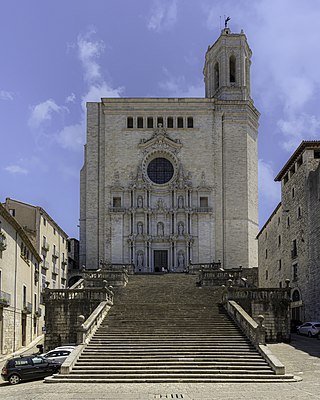
Girona Cathedral, also known as the Cathedral of Saint Mary of Girona, is a Roman Catholic church located in Girona, Catalonia, Spain. It is the seat of the Roman Catholic Diocese of Girona. The cathedral's interior includes the widest Gothic nave in the world, with a width of 23 metres (75 ft), and the second-widest of any church after that of St. Peter's Basilica. Its construction was begun in the 11th century in the Romanesque architectural style, and continued in the 13th century in the Gothic style. Of the original Romanesque edifice only the 12th-century cloister and a bell tower remain. The second bell tower was completed in the 18th century.

The Potemkin Stairs, Potemkin Steps, or, officially, Primorsky Stairs are a giant stairway in Odesa, Ukraine. They are considered a formal entrance into the city from the direction of the sea and are the best known symbol of Odesa.
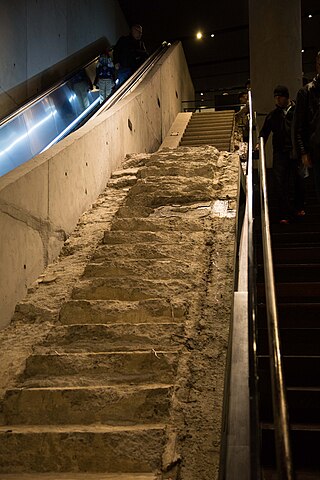
The Survivors' Staircase was the last visible remaining original structure above ground level at the World Trade Center site. It was originally an outdoor flight of granite-clad stairs and two escalators which connected Vesey Street to the World Trade Center's Austin J. Tobin Plaza. During the September 11 attacks, the stairs served as an escape route for hundreds of evacuees from 5 World Trade Center, a 9-floor building adjacent to the Twin Towers. The staircase is now an important feature of the National September 11 Memorial & Museum.

The Crédit Lyonnais headquarters is a Haussmannian style building located in the 2nd arrondissement of Paris. It is on the block formed by Boulevard des Italiens, rue de Gramont, rue du Quatre-Septembre and rue de Choiseul.

The University of Osuna, officially the Colegio-Universidad de la Purísima Concepción en Osuna was a university in Osuna, Kingdom of Seville, Spain from 1548 until 1824. Spain granted the university building the status of a monument in 2004. Since 1995, the building has again been a site for university-level studies.

Two Temple Place, known for many years as Astor House, is a Neo-Gothic building situated near Victoria Embankment in central London, England. It is known for its architecture, and contains notable works by the likes of William Silver Frith, Sir George Frampton, Nathaniel Hitch and Thomas Nicholls.

Palazzo Zuccari, also called Palazzetto Zuccheri, is a 16th-century residence, located at the crossroads of via Sistina and via Gregoriana, with a Mannerist 16th-century facades on the latter street and a late Baroque facade on the piazza Trinità dei Monti in the Campo Marzio neighborhood of Rome, Italy. Designed by Federico Zuccari, the house is known locally as the "House of Monsters" for the decorations on its doors and windows overlooking the via Gregoriana.

François d'Orbay was a French draughtsman and architect who worked closely with Louis Le Vau and Jules Hardouin Mansart.

The Palazzo dei Consoli is a Gothic architecture, civic building in the historic center of Gubbio, region of Umbria, Italy. Construction took place during 1332–1349 under design by Angelo da Orvieto; the palace was built on a large platform built against the hillside and looming over the town below.

